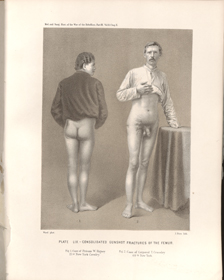Title: Rigney, W.
Source text: The Medical and Surgical History of the War of the Rebellion. (1861-65.), Part 3, Volume 2 (Washington, DC: Government Printing Office, 1883), 178-179.
Civil War Washington ID: med.d2e7827
TEI/XML: med.d2e7827.xml
CASE 361.—Private W. Rigney, Co. G, 21st New York Cavalry, aged 18 years, was shot near Bladensburg, May 27, 1865. Surgeon B. B. Wilson, U. S. V., reported his admission to Stanton Hospital, Washington, May 29th, with "shot wound of right nates and right thigh, fracturing the femur, received while running the guard." The method of treatment, however, was not stated. On September 13th the patient was transferred to Harewood Hospital, whence Surgeon E. B. Bontecou, U. S. V., described his condition as follows: "He was admitted convalescing from a fracture of the upper third of the femur, caused by a revolver ball, the injured bone having firmly united with two inches shortening and very slight deformity. His constitutional condition was good, and he was able to go about on crutches and had good prospects of a useful limb." One month afterwards the man was transferred to De Camp Hospital, David's Island, New York, and on June 26, 1866, he was discharged from service and pensioned. Examiner W. G. Davis, of Lyons, New York, certified, July 1, 1872: "Pistol shot wound of right thigh, the ball entering posteriorly and fracturing the femur just below the trochanter major. There is considerable deformity and two and a half inches shortening. Pieces of bone discharged. Has pain in the limb in damp weather. Cannot rotate the thigh or flex it upon the pelvis, and has pain in it if he works, stands long, or lifts heavy loads." No material changes were reported at subsequent examinations. The pensioner was paid June 4, 1879. Photographs taken at the Harewood Hospital in October, 1865, were contributed by Surgeon Bontecou. (Photo's of Surgical Cases, Vol. 8, No. 4, Card Photo's, Vol. 3, p. 32.) A copy, taken at the Army Medical Museum (Photo. Series, No. 111), is represented in FIG. 1 of PLATE LIX, opp. p. 178.
